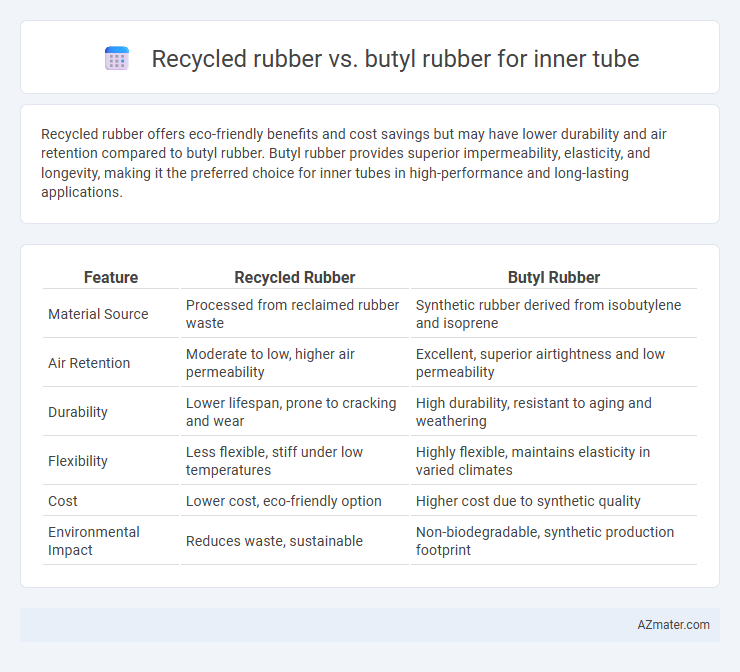Recycled rubber offers eco-friendly benefits and cost savings but may have lower durability and air retention compared to butyl rubber. Butyl rubber provides superior impermeability, elasticity, and longevity, making it the preferred choice for inner tubes in high-performance and long-lasting applications.
Table of Comparison
| Feature | Recycled Rubber | Butyl Rubber |
|---|---|---|
| Material Source | Processed from reclaimed rubber waste | Synthetic rubber derived from isobutylene and isoprene |
| Air Retention | Moderate to low, higher air permeability | Excellent, superior airtightness and low permeability |
| Durability | Lower lifespan, prone to cracking and wear | High durability, resistant to aging and weathering |
| Flexibility | Less flexible, stiff under low temperatures | Highly flexible, maintains elasticity in varied climates |
| Cost | Lower cost, eco-friendly option | Higher cost due to synthetic quality |
| Environmental Impact | Reduces waste, sustainable | Non-biodegradable, synthetic production footprint |
Introduction to Inner Tube Materials
Inner tube materials primarily include recycled rubber and butyl rubber, each offering distinct properties for bicycle and vehicle tires. Recycled rubber provides cost-effective and environmentally friendly options but may lack the airtightness and durability of butyl rubber, which is known for superior air retention, elasticity, and resistance to heat and chemicals. Selecting the appropriate inner tube material depends on balancing performance requirements, longevity, and sustainability considerations.
What is Recycled Rubber?
Recycled rubber for inner tubes is derived from repurposed scrap tires and rubber products, processed to create an eco-friendly, cost-effective material with varying durability and flexibility. Butyl rubber, a synthetic elastomer, offers superior air retention, chemical resistance, and durability compared to recycled rubber, making it a preferred choice for high-performance inner tubes. While recycled rubber emphasizes sustainability, butyl rubber ensures consistent performance and longer service life in demanding applications.
What is Butyl Rubber?
Butyl rubber, a synthetic rubber known for its excellent air impermeability and chemical resistance, is commonly used in inner tubes to ensure long-lasting air retention and durability. Compared to recycled rubber, butyl rubber offers superior resistance to punctures, weathering, and heat, making it a preferred material for high-performance and safety-critical applications. Its unique impermeability properties reduce the need for frequent inflation, enhancing overall tire performance and user convenience.
Durability Comparison: Recycled Rubber vs Butyl Rubber
Butyl rubber exhibits superior durability compared to recycled rubber for inner tubes, offering enhanced resistance to air permeability and punctures. Recycled rubber, while environmentally friendly, tends to degrade faster under repeated stress and exposure to heat, reducing lifespan. The impermeability and elasticity of butyl rubber make it the preferred choice for long-lasting inner tube applications.
Air Retention and Leak Resistance
Recycled rubber inner tubes offer moderate air retention but tend to have higher permeability compared to butyl rubber, leading to more frequent air loss. Butyl rubber excels in air retention and leak resistance due to its dense molecular structure, making it the preferred material for premium inner tubes. Its superior impermeability reduces the likelihood of slow leaks and maintains optimal tire pressure over extended periods.
Environmental Impact of Both Materials
Recycled rubber inner tubes significantly reduce landfill waste and lower greenhouse gas emissions by repurposing scrap tires, making them an eco-friendly option. Butyl rubber, while offering superior air retention and durability, is a synthetic material derived from petrochemicals, contributing to fossil fuel depletion and non-biodegradability. Choosing recycled rubber supports circular economy principles, whereas butyl rubber's environmental impact is larger due to its production process and limited recyclability.
Price Comparison and Cost-Effectiveness
Recycled rubber inner tubes typically cost 30-50% less than butyl rubber alternatives, providing a budget-friendly option for budget-conscious consumers. Butyl rubber offers superior air retention and durability, translating to fewer replacements and lower long-term maintenance costs. When evaluating cost-effectiveness, recycled rubber is ideal for short-term use, while butyl rubber delivers better value in extended, heavy-duty cycling conditions.
Performance in Different Riding Conditions
Recycled rubber inner tubes exhibit excellent durability and environmental benefits, making them suitable for casual and urban riding with moderate puncture resistance. Butyl rubber inner tubes offer superior air retention and elasticity, providing enhanced performance in high-stress conditions such as off-road or competitive cycling. Riders seeking longevity and consistent pressure management in varied terrains often prefer butyl rubber over recycled rubber for inner tube applications.
Maintenance and Repair Considerations
Recycled rubber inner tubes tend to have a higher susceptibility to punctures and require more frequent patching due to their variable composition and lower uniformity compared to butyl rubber tubes. Butyl rubber inner tubes offer superior air retention and resist degradation from sunlight and heat, reducing maintenance frequency and simplifying repair processes. Choosing butyl rubber enhances long-term durability, minimizing the frequency and complexity of inner tube maintenance and repairs.
Which Is Better for Inner Tubes?
Recycled rubber offers an eco-friendly and cost-effective option for inner tubes, but it often lacks the durability and elasticity found in butyl rubber. Butyl rubber excels in air retention and resistance to punctures, making it the preferred choice for high-performance and long-lasting inner tubes. For inner tubes requiring superior airtightness and durability, butyl rubber is generally considered better despite its higher cost.

Infographic: Recycled rubber vs Butyl rubber for Inner tube
 azmater.com
azmater.com